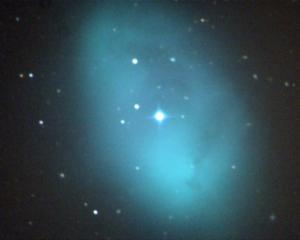Maria Pozza says there was no childhood epiphany that drove her towards her University of Otago PhD topic "The Legal Implications of Outer Space Treaties and International Relations".
The decision to embark on this fascinating area of study came about more organically, blooming from her interest in international relations and a quest to find an academic field that would continue evolving rapidly.
"Space is one of the most interesting topics and what's really exciting is that every day there's something new."
Born in Cambridgeshire, England, she studied at Birmingham City University and completed an honours degree in law before coming to Otago University in 2009 to do her master's degree in international studies.
The course work was broken down into four modules - global politics, economics, history and law - and she describes the 20,000-word master's dissertation as "demanding" but "brilliant" for the research skills it gave her.
Space-based weaponry was at the core of her master's ("it's all a bit Star Trek, isn't it ...") but it seems the legal complexity of galactic politics trumped technology as the focus of her research.
She is tackling the PhD under the joint auspices of the university's Faculty of Law and its Department of Media, Film and Communications Studies.
"It stems from the contextual historical analysis concerning international relations during the Cold War, which led to the formation of international law applicable to outer space."
Rapidly advancing technology guides the application of space law and will create ever more complicated hypotheticals for space-faring nations such as China, "which has a really ambitious space programme", including plans for a manned mission to Mars by 2040.
The concept of a "Red Colony" has excited the imaginations of scientists and sci-fi writers for decades. The terraforming and human colonisation of Mars is another bit of conjecture, raising a kaleidoscope of questions for someone in Pozza's field.
"Mars is the No 1 candidate for terraforming and there will be new problems, new issues and new laws, but it's hard to say what international relations issues would come up.
"Would sovereignty happen? What would be applicable? Would we have separate countries or would it just be Mars? Would we have a Mars passport?"
Life in the crimson biosphere would be subject to international law governing the various links between Earth and Mars. The legal framework of a future Martian society and regulation around the almost impossibly epic task of performing a planetary face-lift have weighty implications.
"It would clearly involve massive and costly atmospheric changes and really heavily advanced technology. All the interest from Hollywood is quite reflective of the importance of these issues."
Initially, she sees the possible colonisation of the planet involving "small, sealed bases where humans can breath in an Earth-type atmosphere."
Numerous international societies and agencies are pushing for the new frontier, including Nasa and the European Space Agency, but technology, science and economics are still trailing light years behind the dream.
However, cosmic detritus, space junk, galactic garbage - call it what you will - is a much more tangible and pressing problem.
"That's a really important issue. There's an environmental impact but also an impact on international relations, causing risks for astronauts, satellites and space shuttle voyagers."
For example, something "as small as a screw" could pierce Nasa's Hubble Space Telescope or damage the International Space Station. It is easy to see how the area in Earth's upper atmosphere is a potential minefield of global liability between space-faring nations.
That's not to mention when two separate pieces of human-made orbital debris collide, creating a third: "It's now split three ways. Who pays for it?
"It's so, so complex. And there are the environmental problems. Space is not rapidly self-cleansing. Debris in low Earth orbit can take 10 to 15 years to enter the Earth's atmosphere where it might burn up."
At higher altitudes this process can take thousands of years. Scientists estimate there are tens of millions of pieces of space junk - including objects as small as paint flakes and as big as dead spacecraft. The effect is likened to a massive, swirling sandblaster - or a particularly abrasive celestial hurricane.
"Space has been filling up with increasing amounts of debris since the launch of Sputnik 1 in 1957 and it becomes harder and harder to keep track of debris. Defunct satellites create tonnes of debris.
"It creates a health and safety issue - the poor astronauts - something needs to be done. More of an international effort needs to be made. Of course it's early days yet and it's dependent on technology, maybe something like a giant Hoover ..."
There is also the possibility that if we don't tidy up space, junk could start landing here with more frequency - like the 1997 case of Lottie Williams, in Oklahoma, who was hit on the shoulder by a piece of fuel tank from a US Air Force rocket deployed the previous year.
So, given the risky nature of space travel - even in Earth's low orbit atmosphere - would she still want to make the leap from Dunedin to the stars?
"Do you think Richard Branson would give me a student discount on a ticket?"












